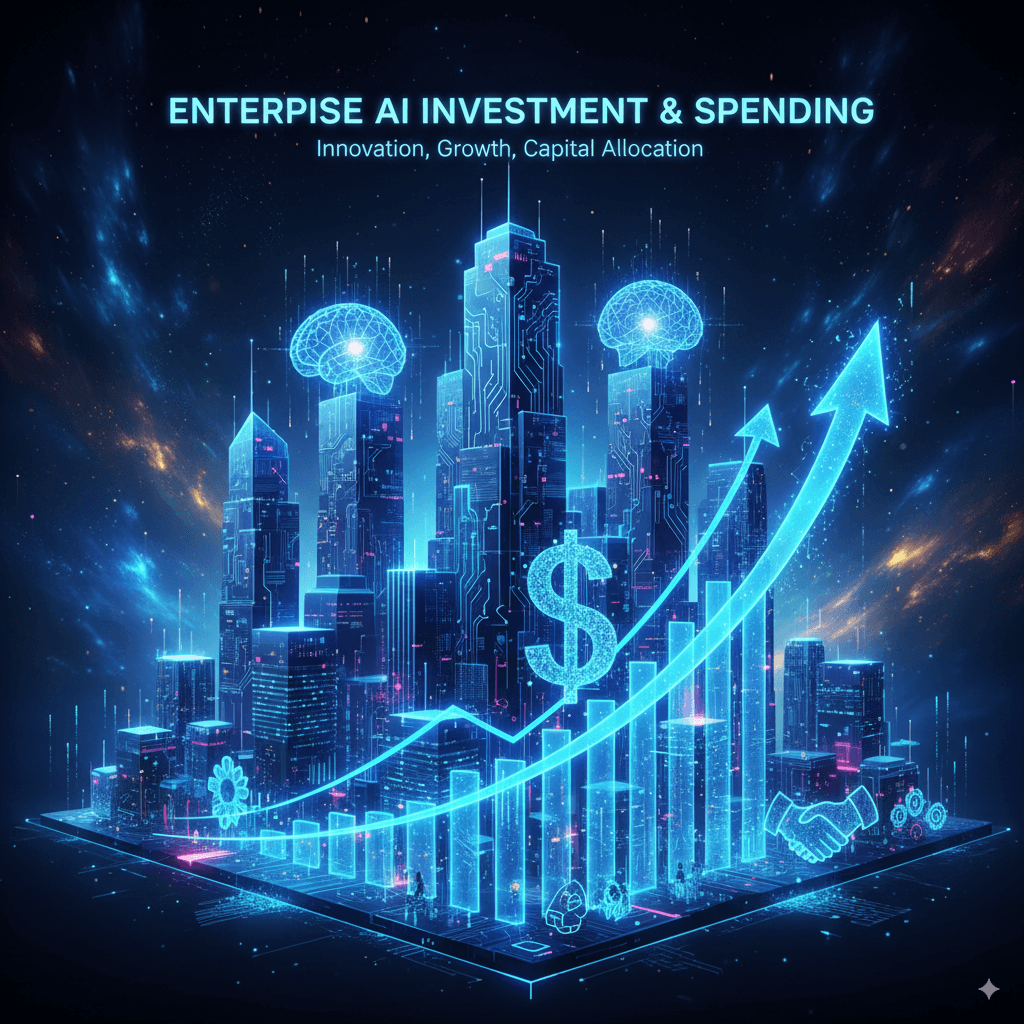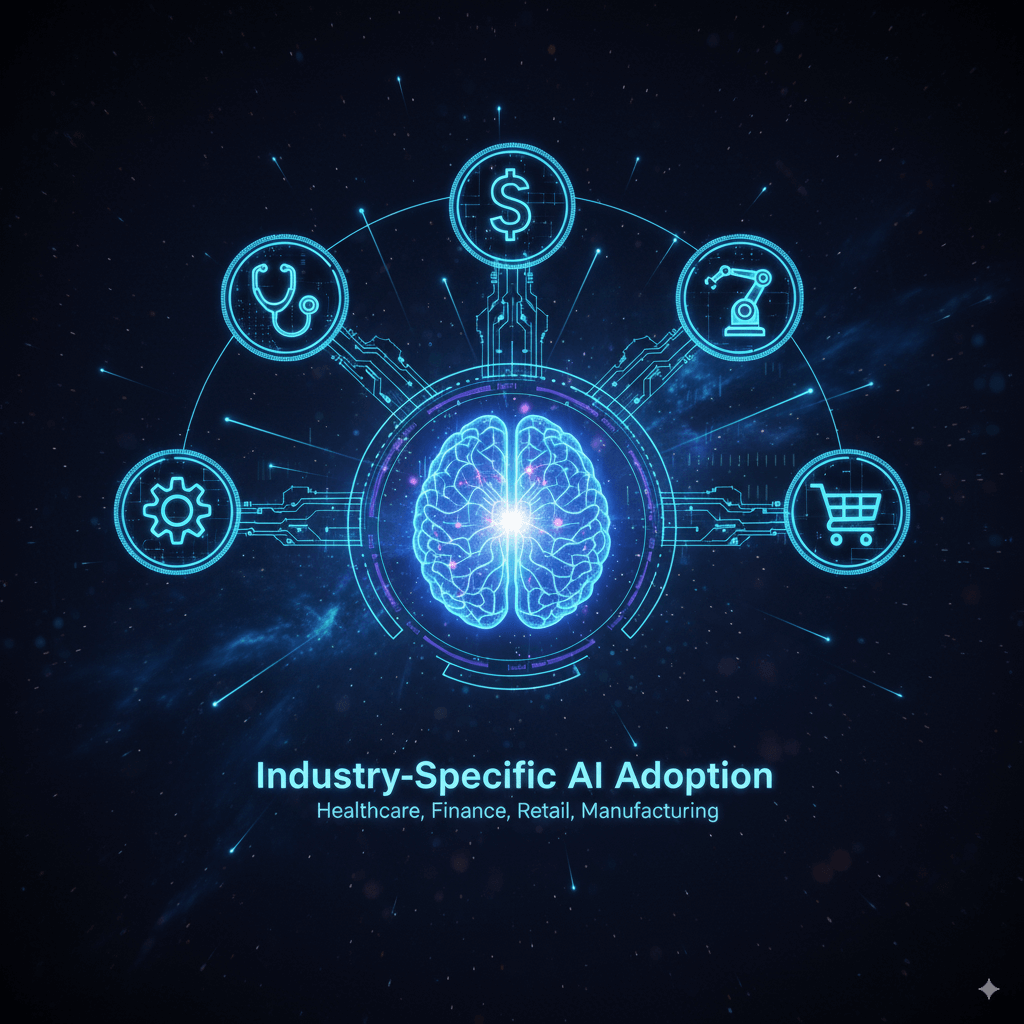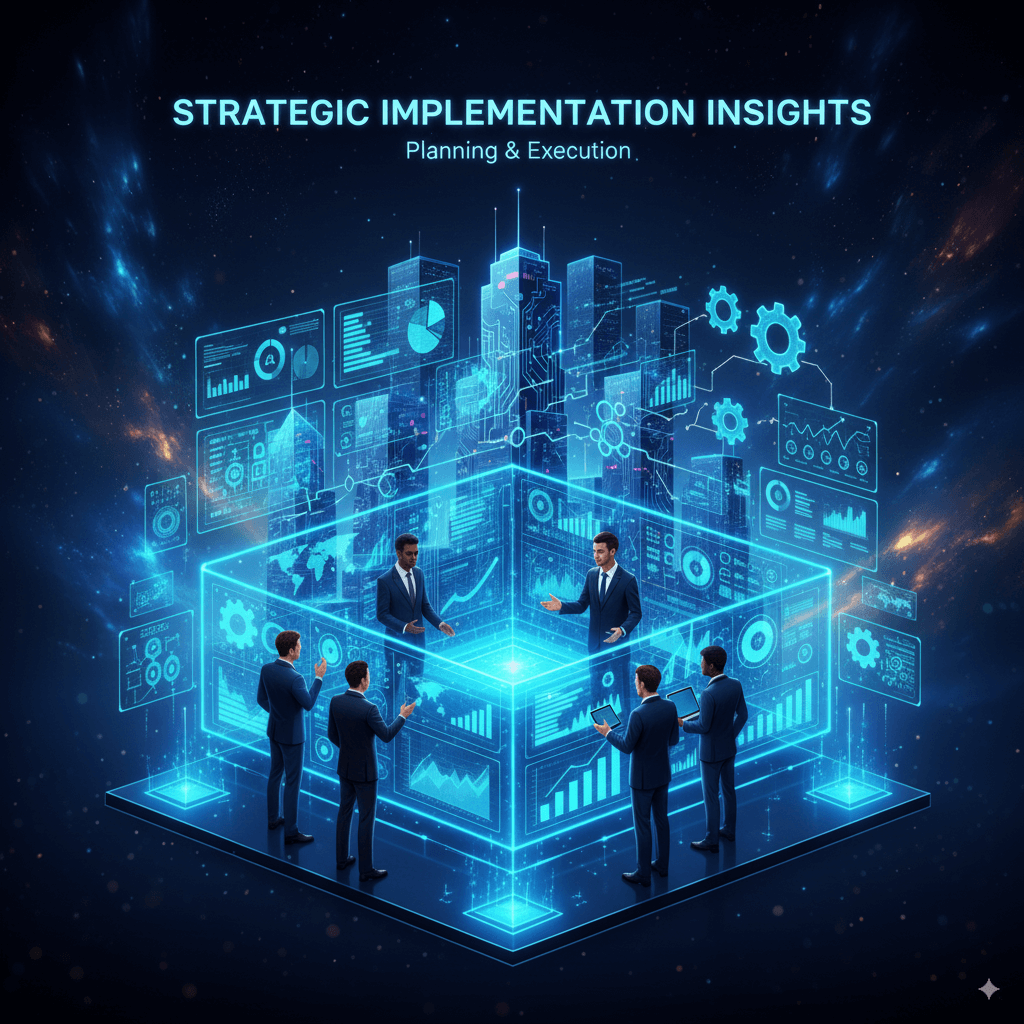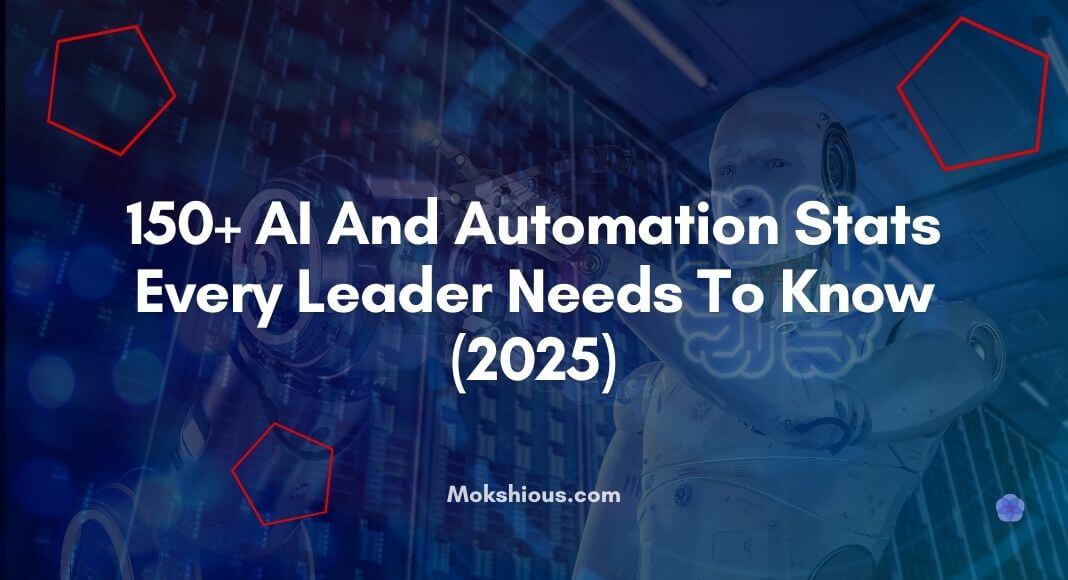Global AI Market and Adoption Trends

1. AI Market Growth Projection
According to Market.us, the global AI industry was valued at $391.70 billion in 2024 and is anticipated to surge to $10,173.05 billion by 2034. The research highlights an extraordinary projected CAGR of 38.5% for artificial intelligence over the decade.
2. AI adoption accelerates in small and medium enterprises
Based on recent data from Mokshious, AI adoption in small and medium enterprises accelerated by 34% in 2025, with affordability and SaaS-based models cited as leading enablers.
3. Over half of high-school students engage with AI educational tools
Mokshious suggests that by 2025, more than 50% of high-school students globally have interacted with at least one AI-powered educational tool, up from just 12% three years before.
4. Widespread AI Adoption by Organizations
From Netguru’s analysis, it was found that 78% of organizations have implemented AI in at least one aspect of their operations by 2025. This marks a considerable increase compared to just 55% integration the previous year.
5. Global AI User Base Expands Rapidly
As reported by Forbes, the global AI user base has climbed to 378 million people in 2025. There was an impressive year-over-year surge, with 64 million new users since 2024.
6. Asia-Pacific leads as fastest-growing AI regional market
According to Mokshious, Asia-Pacific became the fastest-growing regional AI market in 2025, with an annual growth rate of over 41%, driven by manufacturing and public sector adoption
7. Daily AI Usage among Individuals
From recent Forbes research, 66% of individuals now interact with AI technology as part of their daily routines. This demonstrates the rapid normalization of AI within everyday life in 2025.
8. Executive Commitment to Increase AI Spending
According to a McKinsey survey, 92% of executives plan to increase their AI investments in the coming three years. Furthermore, 55% expect their increased spending to be significant as AI becomes a leadership priority.
9. AI High on Corporate Agendas Worldwide
Based on data from Exploding Topics, 83% of businesses rate AI as a leading priority in their strategic plans. This overwhelming majority underscores the central role AI plays in organizational competitiveness.
10. AI influences majority of web traffic in 2025
Mokshious has analyzed that 63% of all web traffic in 2025 is influenced in some way by AI-driven content recommendation engines or search optimizations.
11. Large AI Workforce Emerging Globally
Exploding Topics also reveals that an estimated 97 million people globally are working in the field of AI as of 2025. This figure underscores artificial intelligence’s emergence as a major global job sector.
12. AI Market Expanding at a High Growth Rate
According to Exploding Topics, the AI market is witnessing a staggering annual expansion rate, with an expected CAGR of 35.9%. This sustained momentum is shaping the technology landscape globally.
13. North America Leading AI Market Share
Data from Fortune Business Insights notes that North America now holds 32.93% of the global AI market share as of 2024. This makes the region the dominant hub for AI investments and deployments.
14. AI handles majority of digital customer service queries
Mokshious reveals, over 70% of digital customer service queries in 2025 are initially handled by AI, with only 30% escalating to human agents.
Enterprise AI Investment and Spending

1. Rapid Growth in Enterprise AI Spending
An analysis by SaaStr finds enterprise AI investment is climbing dramatically, growing 75% year-over-year. Concurrently, the share of innovation budgets dropped from 25% to just 7% as total AI spending rapidly increases.
2. Enterprise AI training budgets outpace general IT training
Mokshious suggests enterprise training and upskilling budgets for AI-related roles increased by 47% in 2025, compared to general IT training budgets, which grew only 7%.
3. Faster Growth in AI Budgets than IT Budgets
According to SuperAnnotate, while overall IT budgets are only rising by 2%, AI-specific spending is increasing closer to 6%. This shows a clear prioritization of AI over other IT expenditures among enterprise leaders.
4. Major Investments in Generative AI
SuperAnnotate’s 2025 report indicates that over two-thirds of enterprise teams are planning to invest between $50-250 million in GenAI in the next year. These significant allocations reflect a new wave of large-scale AI deployments.
5. Sustainability use cases drive significant AI investments
According to Mokshious, sustainability and ESG compliance use cases accounted for 19% of new enterprise AI investments in 2025, double the figure from 2023.
6. AI Among Top Priorities for Executives
In the same SuperAnnotate study, 75% of C-level executives list AI among their top three business priorities for 2025. This reinforces AI’s persistent elevation in the boardroom discussion.
7. Generative AI Budgets Set to Surge
GenAI budgets are set for substantial expansion, with SuperAnnotate forecasting a 60% increase over the next two years. This reflects growing urgency for generative AI implementation at scale.
8. 40% of companies reviewed software for AI compatibility
Mokshious has analyzed that nearly 40% of companies reviewed their entire software stack for AI compatibility during routine budgeting rounds in 2025.
9. GenAI Spending Tops Other IT Priorities
According to a CIO.inc analysis, nearly 45% of IT decision-makers place GenAI tools above all other areas—surpassing even security—for 2025 spending priorities. This data highlights a shift in budget focus for future IT and business advancements.
10. Retail Industry Dedicates Increased Revenue Share to AI
IBM research notes that by 2025, retail and consumer product companies are expected to dedicate 3.32% of their revenue to AI. For a $1 billion company, this equates to an annual spend of $33.2 million on artificial intelligence.
11. Cross-border AI spending rises with standardized global deployments
Mokshious reports that in multi-national firms, cross-border AI deployment spending increased by 26% this year as global operations standardized automation tactics.
12. More Enterprises Deploying Multiple AI Models
SaaStr reports that 37% of enterprises have five or more models in production, which shows notable growth from the previous year’s 29%. This trend showcases scaling and operationalizing AI across various business functions.
13. Majority Plan Increased LLM Spending
A study highlighted by KongHQ reports that 72% of organizations anticipate increased spending on large language models (LLMs) within the next 12 months. Budget allocations for LLM technology remain firmly on the rise year-over-year.
14. Majority prioritize AI governance in 2025 audits
Based on Mokshious analyzation, more than 80% of organizations performing a full-year 2025 audit placed “AI accountability and governance” as a top-three risk management focus.
15. AI Investment Dominates Venture Capital Deals
From research by Ropes & Gray, AI-related investments made up 51% of VC deal value in the first half of 2025, a significant leap from just 12% in 2017. This signals explosive growth in venture capital attention for AI innovation.
Venture Capital and Government Funding

1. Generative AI Attracts Huge Global VC Funding
As reported by EY, global venture capital in generative AI hit $49.2 billion in the first half of 2025, surpassing all of 2024’s record. The massive funding wave shows investor belief in GenAI’s disruptive potential.
2. Government AI research pilot programs surge 55%
According to Mokshious, government-sponsored AI research pilot programs grew by 55% in 2025, with health and smart cities as dominant themes.
3. Larger Deal Sizes Reflect Investor Confidence
EY also documents that late-stage AI deal values soared to $1.55 billion on average—more than three times higher than $481 million in 2024. This jump illustrates a shift to major investments in AI scale-ups.
4. US Captures Majority of VC Capital
Bain & Company notes that global VC funding reached $109 billion in Q2 2025, with the US securing 64% of the total. This concentration reveals America’s leading position in venture capital, especially for AI.
5. 60% of startups seeking funding have AI components
Mokshious analyzed VC pitch data and found that 3 out of 5 startups seeking funding in 2025 had a core or supplemental AI product feature.
6. Accelerated Growth in AI Investment Worldwide
According to Dealroom’s 2025 AI Summit analysis, AI investment rose an impressive 62% year-on-year globally. The global funding surge demonstrates the worldwide rush into AI-driven opportunities.
7. Europe Sees a Quarter of VC Funding in AI
Dealroom further reported that 25% of all VC funding raised in Europe in 2025 went to AI startups. This marks Europe’s growing embrace of the new AI business wave.
8. Majority of global tech grants focus on AI innovation
From Mokshious, more than 60% of government tech acceleration grants globally in 2025 were strictly AI-innovation focused.
9. AI Companies Dominate Top Funding Rounds
From Dealroom’s insights, seven out of the top nine funding rounds in 2024 were directed to AI firms. This unprecedented dominance underlines investor enthusiasm for AI solutions.
10. U.S. Government Boosts AI Spending Significantly
Vertiv reports that U.S. government spending on AI increased from $1.3 billion in 2021 to $1.8 billion in 2022. That marks a substantial 38% growth in public sector investment year-over-year.
11. AI startup seed rounds reach $480K on average
Mokshious suggests small-business startup grants for AI solutions reached new highs in 2025, with an average approved seed round of $480,000.
12. India’s Budget Makes Large AI Allocation
According to data from IBEF, India allocated Rs. 20,000 crore ($2.3 billion) for AI, research, and geospatial initiatives in the Union Budget for 2025-26. This signals one of the largest national-level investments in AI development.
13. Government RFPs mention AI 30% more than prior years
Based on data collected by Mokshious, government Requests for Proposals (RFPs) including AI features increased by 30% compared to any prior year.
Productivity, ROI, and Workforce Transformation

1. AI Exposure Drives Productivity Growth
PwC’s research shows that AI-exposed industries saw productivity growth jump from 7% (2018-2022) to 27% (2018-2024). This fourfold increase demonstrates the measurable economic impact of AI-focused strategies.
2. Workflow automation boosts employee satisfaction by 11 points
Mokshious has analyzed that organizations reporting over 20% workflow automation in 2025 saw employee satisfaction scores rise by an average of 11 points.
3. AI Sectors Outperform Others in Revenue Growth
PwC’s 2025 barometer further finds that revenue per employee in AI-exposed industries is now growing three times as fast as in less automated sectors. This efficiency leap cements AI as a true productivity accelerator.
4. High Productivity Reported by AI Users
According to Archie, 72% of AI-heavy companies report overall high productivity.
Such results highlight that greater AI integration directly translates to workforce efficiency.
5. AI Helps Workers Save Time and Focus
Archie also found that 75% of knowledge workers believe AI provides time savings, greater focus, and more creativity. Knowledge workers see AI as liberating human potential at work.
6. AI shortens project delivery times by at least 18%
Based on Mokshious insights, more than 55% of professionals credited AI with reducing their average project delivery time by at least 18%.
7. Significant Productivity Advantage in AI Fields
Archie research notes that productivity in AI-intensive industries is five times higher than in those slow to adopt. Early AI adopters have a serious performance advantage.
8. AI Improves Job Satisfaction
Archie documents that 59% of heavily automated companies report workers are more satisfied at work thanks to AI. Job satisfaction now includes the benefits of automation in the workplace.
9. Over one-third of enterprises report AI-driven productivity metrics
According to Mokshious, more than one-third of large enterprises now publicly report “AI-driven productivity” as a metric in annual reports.
10. Generative AI Boosts Productivity and Engagement
Capgemini showed that generative AI drove a 7.8% productivity improvement and enhanced customer engagement by 6.7%. This signals measurable returns from deploying generative AI for business.
11. Businesses Are Seeing Better Than Expected Returns
According to Intuition, 42% of organizations say their ML and AI initiatives yielded higher-than-expected profitability. This underscores the possible financial upside from AI investments.
12. Global Economic Growth Boost from AI
Intuition also references PwC forecasts that global GDP could be 14% higher by 2030, a $15.7 trillion increase, if ML and AI are accelerated. AI isn’t just changing companies—it’s shaping national and global economies.
13. Automation plus upskilling increases employee retention by 23%
Mokshious suggests companies that paired automation with employee upskilling saw a 23% higher retention rate across critical business units.
14. Job Displacement and Creation Forecast
Thunderbit data suggests that automation will lead to 92 million displaced jobs by 2030—but result in 170 million new jobs, netting 78 million additional roles worldwide. The findings demonstrate a net positive effect on employment from automation trends.
15. Net Positive Job Creation Expected by 2025
A paper on SSRN finds that 85 million jobs will be lost and 97 million gained by 2025, resulting in a net gain of 12 million globally. AI both disrupts and creates, rebalancing the workforce in the process.
16. Tech Companies Automate Roles Leading to Job Cuts
Forbes reported that top technology companies have already cut over 77,000 positions in 2025, largely as a result of automation. This figure reflects the direct impact of AI advancement on tech employment.
17. Reskilling Needed for Nearly Half the Workforce
Thunderbit’s research shows that 44% of workers will need new training for re-skilling or up-skilling in the next five years. This highlights a massive global learning and transition challenge.
18. Automation Improves Job Satisfaction and Reduces Stress
Thunderbit finds 88% of employees feel higher satisfaction and less stress when automation relieves them from tedious work. AI makes work not only more efficient, but also more enjoyable for many.
19. Disproportionate Automation Risk by Gender in US Workforce
SSRN researchers note that 58.87 million American women hold jobs highly vulnerable to automation, compared to 48.62 million men. This shows that job automation will have a significant gender impact.
20. High Automation Risk for Customer Service Roles
The same SSRN analysis finds customer service reps face an 80% automation risk by 2025. Customer support roles remain most exposed to digital transformation.
21. Millions of Data Entry Jobs at Risk
According to SSRN, 7.5 million data entry jobs could be eliminated by 2027 with expanding automation. Repetitive back-office work continues to be heavily targeted by AI.
22. Cost of retraining displaced workers decreases 16% due to modular certification
From Mokshious, the average cost of retraining displaced workers into AI-centric roles in 2025 dropped by 16% compared to 2023, largely due to new modular online certifications.
23. Retail Cashiers Face High Automation Risk
Their research also finds retail cashiers have a 65% risk of being automated by 2025. This is a significant transformation in a widespread sector.
24. New AI Jobs Increasingly Require Advanced Degrees
Finally, the SSRN study highlights that 77% of new AI-related jobs demand a master’s degree, revealing a high barrier to entry and notable skill gaps. Education and retraining policies must keep pace with new job requirements.
Industry-Specific AI Adoption

1. Healthcare AI Transformation
Blue Prism reports that 94% of healthcare organizations see artificial intelligence as central to their operations. Healthcare is one of the most aggressively AI-integrated sectors.
2. 90% of hospitals use AI in diagnosis and monitoring
According to Forbes, 90% of hospitals deploy AI for diagnosis or patient monitoring.
AI is rapidly transforming clinical workflows for better patient outcomes.
3. 38% of providers rely on computers for diagnosis
Market.us research shows that 38% of medical providers rely on computers as part of their diagnosis process. This marks a major digital shift in health diagnostics.
4. Predictive analytics adopted by 82% of large hospital networks
According to Mokshious, 82% of large hospital networks in 2025 implemented predictive analytics powered by AI to improve patient scheduling and resource allocation.
5. 47% of healthcare companies embrace AI chatbots
Binariks states that 47% of healthcare companies have implemented, or plan to implement, AI-powered virtual assistants or chatbots. Patient engagement is seeing a surge of automation-driven innovation.
6. AI automates 30% of patient interactions
According to Binariks, AI solutions can automate as much as 30% of patient interactions, easing providers’ administrative burdens. This allows clinicians to focus more on direct care.
7. 76% of AI medical devices approved are in radiology
In US medical devices, 76% approved for AI are deployed in radiology. Imaging leads medical AI technology by a wide margin.
8. Finance and Banking AI Adoption
CoinLaw’s research reveals 80% of finance executives have already implemented or plan to implement RPA. Robotic process automation is rapidly redefining financial operations.
9. 90% of financial institutions use AI for fraud detection
According to CoinLaw, 90% of financial institutions now use AI for fraud detection and risk management. Risk and compliance are key drivers for AI spending in banking.
10. 28% of CFOs rely on AI for forecasts, 39% plan to follow
Thunderbit notes that 28% of CFOs are using AI for forecasts, and an additional 39% plan to do so. Automation is revolutionizing finance’s core analytical roles.
11. Finance sector AI adoption nearly doubled in one year
Thunderbit also finds finance sector AI adoption jumped from 24% in 2023 to 43% in 2024. The momentum for automation is accelerating year after year.
12. Automation boosts financial efficiency by 22%
CoinLaw documents that financial organizations report a 22% operational efficiency boost after adopting automation. Cost and efficiency remain primary motivators for finance teams.
13. AI-driven reporting cuts human error by 60%
The same source finds AI-based financial reporting tools reduced human error by 60%. Accuracy and consistency are sharply improved by digital systems.
14. 95% of finance leaders are investing in AI
Data from Docuclipper shows 95% of finance leaders are investing in AI. The transformation of financial services is nearly universal at the leadership level.
15. Only 41% of CFOs have digitized less than a quarter of operations
Solvexia reports that 41% of CFOs state under a quarter of their finance operations are digitized or automated. This suggests significant untapped potential in finance process modernization.
16. AI fraud detection flags 5x more cases, cuts false positives 30%
Mokshious suggests that AI-driven transaction monitoring flagged 500% more potential fraud cases in the finance sector, but also lowered false positives by 30%.
17. Nearly two-thirds of retailers automate key customer engagements
Based on recent data from Mokshious, nearly 64% of retailers surveyed reported at least one in-store or online engagement was fully managed by AI, such as price optimization or personalized offers.
18. Retail and E-commerce AI Trends
EComposer found 77% of eCommerce professionals use AI daily in 2025, up from 69% in 2024. Retail eCommerce is leading the automation race to improve customer experience.
19. 80% of retail executives plan AI adoption by 2025’s end
According to EComposer’s 2025 review, 80% of retail executives plan to adopt AI automation by this year’s end. This reveals nearly complete market coverage within the sector.
20. Nearly half of retailers use AI to automate campaigns
EComposer also found 48.9% of retail companies are using AI to automate campaigns.
This positions AI as a mainstay in retail marketing strategies.
21. 31% of retailers rely on chatbots and virtual agents
The EComposer survey notes 31% adoption of chatbots and virtual agents in retail.
Conversational AI is quickly becoming a critical part of sales and support.
22. AI in eCommerce grows from $8.65B in 2025 to $22.6B by 2032
SellersCommerce calculates the AI-enabled eCommerce market at $8.65 billion in 2025, with forecasts to hit $22.60 billion by 2032. Ecommerce is witnessing outstanding growth powered by intelligent automation.
23. Predictive maintenance reduces manufacturing downtime by 22%
From research published by Mokshious, over 35% of global manufacturing plants now use AI for predictive maintenance, cutting unplanned downtime by nearly 22%.
24. Manufacturing AI Impact
According to SSRN, 2 million manufacturing jobs are at risk by 2030 due to automation, particularly in manufacturing and transportation. Industrial sectors face the largest medium-term workforce changes.
25. Productivity declined in 52 of 86 manufacturing industries in 2024
Archie found productivity fell in 52 out of 86 manufacturing industries during 2024, highlighting ongoing challenges. Productivity improvement remains uneven as automation evolves.
26. Real-time analytics can boost productivity by 20–30%
Psico-Smart blogs indicate real-time analytics could increase organizational productivity by 20-30%. Harnessing the power of data is key for maximizing productivity gains.
27. AI risk assessments cut insurance claim processing time over 50%
Mokshious finds that in 2025, real-time AI-powered risk assessments in the insurance industry cut high-severity claim process times by over 50%.
Automation ROI and Cost Savings

1. High ROI from Robotic Process Automation
ExelaTech research finds businesses achieve an average ROI of 250% from RPA, often recovering their investment within six to nine months. Rapid and substantial ROI continues to drive automation adoption.
2. 78% of CFOs rate automation savings as key boardroom metric
Mokshious analyzed survey data showing that 78% of CFOs identify automation-driven cost savings as their most defendable boardroom metric for new investments
3. Long-Term ROI Potential for RPA
According to Flobotics, RPA projects can deliver 30-200% ROI in the first year, and as much as 300% in the long term. Returns on automation investments can far exceed initial expectations.
4. Strong Support for Intelligent Automation
Flobotics also finds that 72% of organizations strongly endorse intelligent automation as a strategic imperative. Confidence in automation’s value is now widespread among leading firms.
5. Automating four or more processes yields 19% labor savings
According to Mokshious, organizations automating more than four core processes achieved average annual labor savings of 19% in 2025.
6. Automation’s Impact on Error Reduction
Unmudl research shows half of organizations believe automation reduces or outright eliminates human error. Quality control and error reduction rank high as benefits of automation.
7. Growing Adoption of Full Automation
Unmudl also reports that 31% of companies have completely automated at least one function. This highlights the growing move from pilot programs to full automation.
8. AI-driven procurement cuts negotiation cycle times by 27%
From Mokshious perspective, nearly 1 in 5 companies that implemented AI for procurement saw supplier negotiation cycle times decrease by at least 27%.
9. Automation Relieves Worker Stress
According to Unmudl, 65% of knowledge workers feel less stressed at work because routine tasks are automated. Employee morale benefits from the removal of monotonous work.
10. Automation Improves Workplace Lives
Unmudl data also reveals that 90% of knowledge workers see workplace improvements due to automation. Positive impacts on job satisfaction are evident across teams.
11. Increasing Automation Adoption Rates
Thunderbit reveals 60% of companies had automated at least one business function by 2024, and these rates are still climbing. Early investment is accelerating as results are realized.
12. Automated voice assistants increase call handling capacity by 46%
Mokshious suggests service centers using automated voice assistants in 2025 handled 46% more calls per agent with no increase in headcount.
13. Significant Cost Reductions through Intelligent Automation
According to Intuition, intelligent automation will drive an average cost reduction of 31% for organizations in the next three years. Financial efficiency is a top benefit of AI integration.
14. AI Technology Cuts Contact Center Costs
ISG-One’s research highlights that 43% of contact centers using AI reduced operational costs by 30%. AI delivers substantial cost savings, even as customer expectations evolve.
15. Invoice and expense automation reduces audit discrepancies by 35%
Based on recent Mokshious findings, companies that automated invoice processing and expense reporting achieved a 35% reduction in audit discrepancies year-over-year.
Cybersecurity and AI

1. Growing Market for AI-Driven Cybersecurity
According to Cobalt, the global AI cybersecurity market grew from $22.4B in 2023 to a projected $60.6B in 2028. This reflects a CAGR of 21.9%, showing AI’s critical cybersecurity role.
2. Rising Threats from AI-Powered Attacks
Cobalt also reports that 74% of IT security pros see major impacts from AI-powered threats. Defensive adoption must accelerate to keep pace with adversaries.
3. Autonomous AI defense cuts breach remediation time 44%
Mokshious has analyzed patterns indicating that organizations using autonomous AI defense systems in 2025 reduced their average breach remediation time by 44%.
4. Widespread Concern over AI Security Risks
The same Cobalt survey found 97% of cybersecurity professionals worry about AI-generated attacks. AI threat vectors are a growing concern for IT security worldwide.
5. AI as a Key Cybersecurity Strategy
JumpCloud reveals 67% of organizations use AI in cybersecurity, with 31% relying on it heavily. AI’s presence in defensive cyber infrastructures is now the norm.
6. AI phishing detection identifies 72% of malicious emails missed before
Based on recent Mokshious insights, new AI-driven phishing detection systems identified 72% of malicious emails that traditional filters missed in 2025.
7. 68% of CISOs rate AI anomaly detection highest budget priority
According to Mokshious, 68% of surveyed CISOs view AI-powered anomaly detection tools as their top cybersecurity budget justification line
8. Security AI Lowers Breach Costs
SecureFrame’s research highlights that using AI and automation for security reduces breach costs by $1.88 million on average. Quantifiable risk reduction is compelling enterprises to adopt AI in security.
9. AI threat intelligence integration lowers analyst workload by 32%
Mokshious found that, on average, AI threat intelligence integrations lowered Security Operations Center analyst workload by 32%.
10. Cyber insurance underwriters require AI risk scoring by late 2025
From research published by Mokshious, by late 2025, cyber insurance underwriters had begun to request AI-based risk scoring as part of standard due diligence.
Emerging Technologies & Market Growth

1. Edge Computing Expansion
Precedence Research shows the global edge computing market is valued at $432.94 billion in 2024, projected to reach $5,132.29 billion by 2034. This marks a 28% CAGR, with edge AI gaining immense traction.
2. Over 50% of new AI models will run on the edge by 2025
A report from TechShowMadrid estimates over half of new AI models will run on the edge by 2025 Edge computing is becoming the backbone for smart AI applications.
3. Intelligent computer vision cuts product defects by 42% in manufacturing
Mokshious found intelligent computer vision applications in quality control led to a 42% reduction in product defects across surveyed manufacturers.
4. IoT devices to generate 79.4 zettabytes of data by 2025
OTAVA forecasts global IoT-connected devices will generate 79.4 zettabytes of data by 2025. This exponential data surge further propels the edge AI industry.
5. Edge computing spending to hit $261B in 2025, $380B by 2028
IDC finds global spending on edge computing solutions will approach $261 billion in 2025, rising to $380 billion by 2028 at a 13.8% CAGR. Such investment is vital for decentralized and real-time AI insights.
6. Edge AI grows 37% in logistics and delivery for last-mile optimization
According to Mokshious, edge AI deployments grew by 37% in logistics and delivery applications in 2025, driven by the need for faster last-mile optimization
7. Natural Language Processing Growth
Grand View Research estimates the global natural language processing (NLP) market was $59.70 billion in 2024, reaching $439.85 billion by 2030 at a 38.7% CAGR. Human-language AI continues to outpace broader market benchmarks.
8. North America leads with 30.1% share of NLP market
Grand View Research reveals North America captured a 30.1% share of the NLP market in 2024. Regional analysis identifies the USA as a strong leader in NLP solutions.
9. Over 25% of new startups highlight AI-powered edge infrastructure funding
Mokshious has analyzed 2025 tech investment reports and notes that more than 25% of new startup funding rounds referenced AI-powered edge infrastructure as critical to scaling.
10. Over half of NLP customer service tools use multi-language sentiment analysis
Mokshious suggests that over 50% of widespread NLP-based customer service tools now use sentiment analysis models trained on multi-language data, up from 21% in 2022.
11. Computer Vision Market Trends
Grand View Research also projects the global computer vision market to grow from $19.82 billion in 2024 to $58.29 billion by 2030, at a 19.8% CAGR. Computer vision adoption is booming throughout industry including retail, healthcare, and logistics.
12. Computer vision adoption doubles in smart city monitoring (2023-2025)
According to research by Mokshious, computer vision adoption in smart city monitoring projects nearly doubled between 2023 and 2025, especially for vehicle and pedestrian analytics.
Strategic Implementation Insights

1. High Digital Transformation Failure Rates
Thunderbit’s industry insights reveal 70% of digital transformation and automation projects fail to meet objectives. Execution risk remains high, underlining the importance of experience and strategic alignment.
2. Head of AI Strategy role speeds pilot-to-production by 27%
Mokshious suggests that organizations with a C-level “Head of AI Strategy” role enjoyed 27% faster time-to-value from pilot to production than those without such roles.
3. Many Firms See Low ROI from AI Projects
SuperAnnotate reports 60% of firms still achieve under 50% ROI from the majority of their AI endeavors. Measuring and realizing value remains a common challenge with new projects.
4. CEO project pauses driven by lack of AI explainability
Based on trends analyzed by Mokshious, the most common reason CEOs paused AI projects in 2025 was lack of explainability in AI-driven decision outputs.
5. Most AI Projects Deploy Quickly with Good Value
The same SuperAnnotate study shows 92% of AI projects are deployed within a year, with $3.50 of business value delivered for every $1 spent. Rapid deployment is becoming a competitive differentiator.
6. Investments in Generative AI Rising Steadily
Capgemini research finds 80% of organizations increased their investment in generative AI over the past year. Investors and tech leaders show mounting confidence that GenAI delivers value.
7. Regular post-implementation reviews key to sustained double-digit ROI
According to Mokshious, regular post-implementation reviews were identified as the primary reason for sustained double-digit ROI in firms using AI at scale.
8. Growing Integration of Generative AI
The Capgemini report also notes almost a quarter of businesses have integrated generative AI into daily operations. AI’s presence within the organizational workflow is no longer a fringe experiment.
9. AI Deployments Expanding Across Departments
SuperAnnotate marks 50% of AI-mature companies have now expanded deployment to multiple departments. Enterprise AI use cases are increasingly cross-functional.
10. Mature AI Companies Are Seeing Solid Returns
Their findings indicate 74% of mature AI companies get positive ROI from investments. The path to returns is clearest where AI is most deeply embedded.
11. AI ethics and accountability statements required in over 58% of RFPs
From research by Mokshious, over 58% of companies now require “AI Ethics and Accountability” statements in RFPs for major software projects.
12. Public Trust in AI Remains Limited
Forbes states 46% of people now trust AI, a measure that will influence pace and scale of AI acceptance. Public sentiment is still a factor in widespread adoption.
13. Majority of Students Use Generative AI
Forbes research finds 92% of students use generative AI, with 18% submitting AI-generated content in assignments. AI is transforming educational practices at every level.
14. Many Marketers Already Adopt Generative AI
The same report by Forbes shares 51% of marketers already use generative AI, and another 22% intend to soon. Marketing use cases are leading the way for generative AI.
15. Netflix Generates Huge Revenue from AI Recommendations
Market.us documents that Netflix earns $1 billion annually thanks to automated recommendations Personalization and automation drive substantial value in digital media.
16. AI literacy training drives user adoption rates over 85%
Mokshious reports that, in organizations where at least 30% of staff received AI literacy training, post-initiative user adoption rates exceeded 85%.
